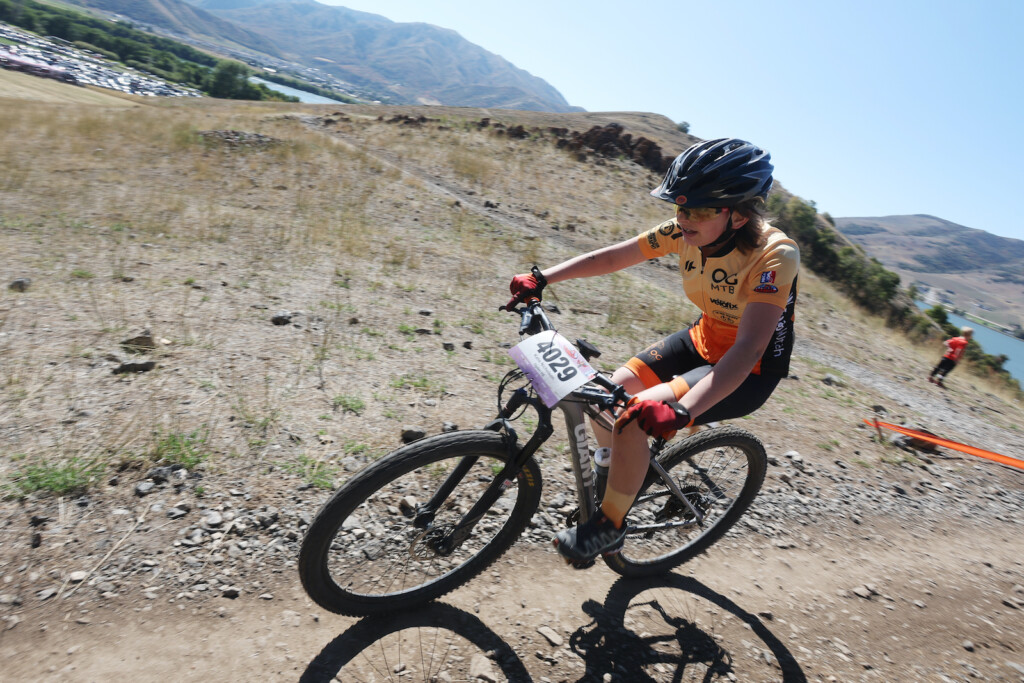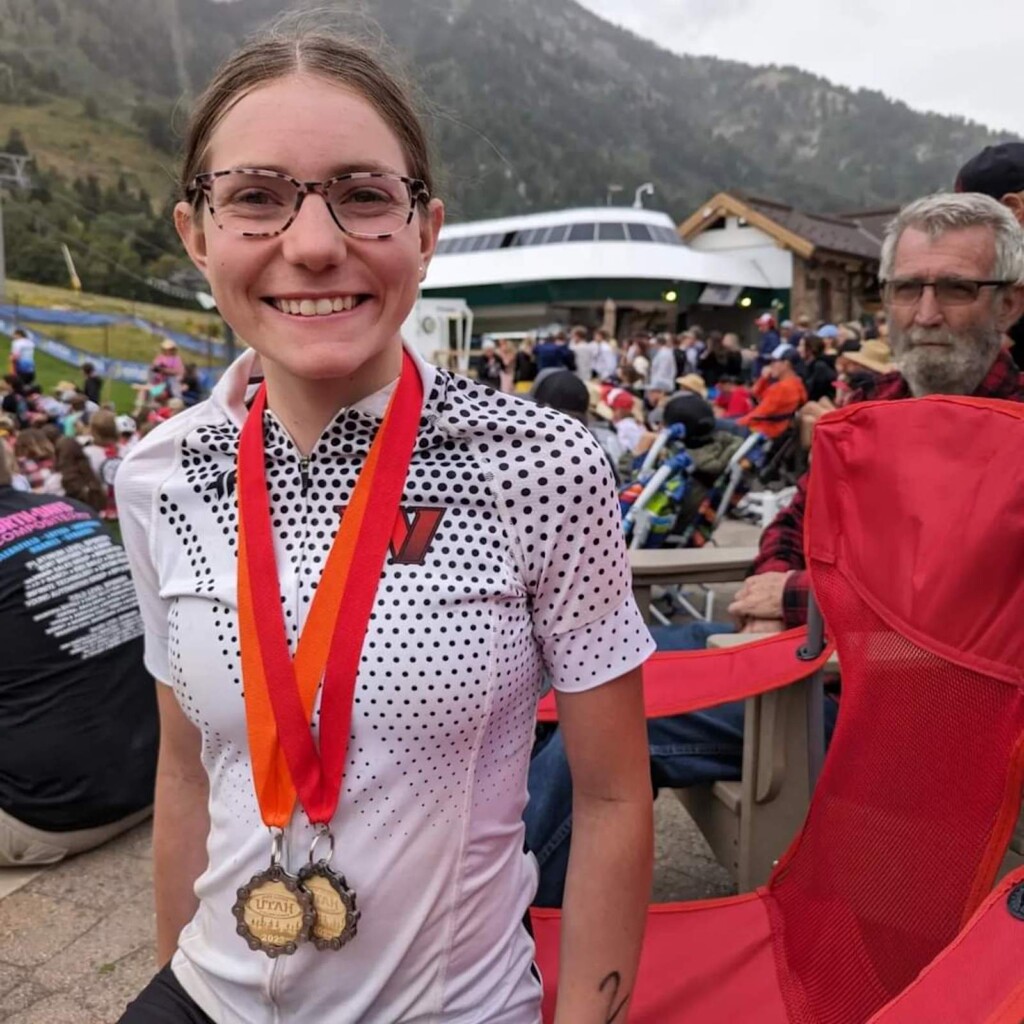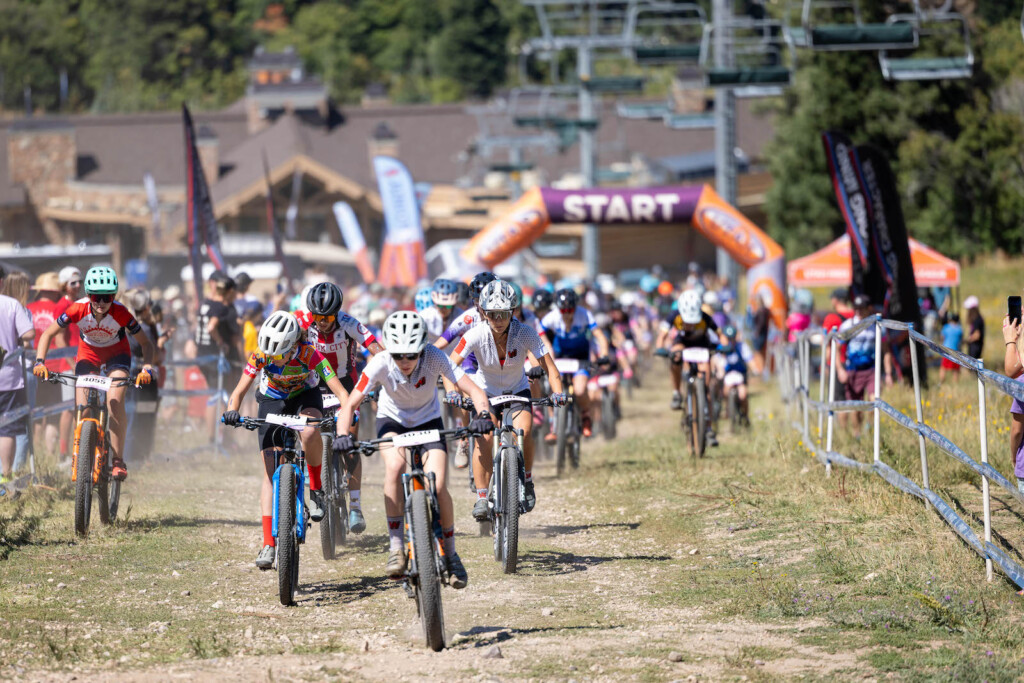Fourteen-year-old Clara Geddes pedaled her bike along a trail, frantically scanning the trees for pink ribbons. She was three miles into a five-mile mountain bike race at Powder Mountain, called the Wildflower Trailfest, on a course she had never ridden, and she hoped she hadn’t missed a turn.
“Am I going the right way?” she yelled when she saw her friend’s dad, a lone spectator, standing near a bridge crossing.
“Yes!” he said. “Go, Clara!”
Clara realized she was leading the race and her adrenaline surged. Although she had been working to improve her skills and speed over the past two years, she expected last year’s winner to catch up.
For Clara and her Ogden High School mountain bike team, the event was practice for the race season, which started in August and culminates with the state championship race in October. Usually, the girls train and race alongside the boys. But on this day, boys weren’t allowed. The team calls the all-girl, once-a-month outings (ranging from bike rides to pool parties) GRiT, or girls riding together, which is part of a nationwide effort to increase the number of high school female mountain bikers.
Utah’s leading that charge. Not only does the state have the largest high school mountain bike league in the nation, but it also has the league with the most girls. Last season, Utah registered 1,732 girls across 77 teams, according to Sarah Zaki, grants manager for the National Interscholastic Cycling Association. The next highest was Northern California’s league with 507.
But female participation numbers still aren’t high enough, according to Dallen Atack, director of the Utah High School Cycling League. He said the league’s goal, mirroring the national goal, is to increase the number of riders who are girls to 33%. This season, Utah’s female riders from 7th through 12th grade fell short of that, making up 26%. That’s slightly up from last year, Atack said. He happily points to another metric: when looking at only 7th and 8th grade riders who are part of the junior development team, girls make up 30%.
Still, growth as a percentage is hard to maintain because the number of boys keeps increasing every year, too. “The league went from 300 to 7,300 in 12 years,” Atack said, making mountain biking Utah’s fastest growing high school sport.
Katie Nicholson, 14, rides on the Ogden High team. “I feel like people automatically think it’s a boy’s sport,” she said. “When I tell my friends about being on the team, they say, ‘That’s so hard.’” And to be fair, it is.
Katie recalled how last year she ate too close to her first practice and threw up. “I went back the next week and ended up having a lot of fun,” she said. Although there are challenging parts to every ride, “after you do it, you feel a lot better about yourself.”
That confidence trickles out to other parts of life, which Kelly Crawford, Ogden High’s training coach and GRiT leader, knows from personal experience. She raced for three decades, including nine years as a professional category one racer, and won three national titles.
“Biking teaches you about life,” she said. “Things don’t always go right and you have to learn from that and move on.”
Crawford recalls years of training where she was the only woman on group rides. “All I did was ride with guys.” As a result, she trained like the guys, too. Now, as a coach, she advises female athletes to do otherwise, backed by recent research from exercise physiologist Dr. Stacy Sims, who trademarked the motto, women are not small men.

Crawford implores the girls to not miss their periods by undereating and to avoid diets. She encourages them to track their menstrual cycles because the natural fluctuations in hormones affect nutrition and hydration needs, as well as their bodies’ ability to respond to high-intensity training. If the girls balk at racing with their period, Crawford tells them not to worry. “The day you start your period, it’s like flipping a light switch,” she said. “You are strong. It’s the five to seven days before that are hard.”
The girls on the team say hearing this from a woman resonates. It points to another objective of GRiT, which is to increase the number of female coaches. Right now, female coaches in Utah’s league make up 26%.
Amy Gompert, a teacher at Snowcrest Jr. High, became the head coach of Weber High’s junior development team last year. She learned to mountain bike with her kids. This season she oversees 53 riders, nine of whom are girls.
“We tell them right up front, hey, this is not always fun,” she said. Even though she starts beginners with short rides, pedaling uphill requires strength and determination, and a rider can’t simply stop halfway through because they’re tired. “It’s the first time a lot of these kids have had to push through something and work hard, and realize I can do this.”
Her daughter, Jane, who’s been riding for three years, had to learn to contend with pre-race jitters. Like other girls, she used to feel so anxious before races that she’d sometimes cry. Now at races, Jane calms her nerves by talking to the girls around her. Once she starts riding, Jane said the stress disappears. In the first two races of the season, Jane placed in the top three among the freshman girls. In the third race in Mantua, she placed first.

For most of the girls, mountain biking is about team camaraderie and self-improvement. At the Wildflower Trailfest, Clara biked past another girl and they cheered each other on. “It just felt good because I knew she was supporting me even though I was passing her,” she said. “I feel like girls are so supportive.”
As Clara began descending the last mile of switchbacks, she took a deep breath, remembering the advice from her coaches to bend her arms and relax. Mountain biking has helped her learn to be more patient. “I’m doing the best I can do,” she told herself while rounding a turn. She crossed the finish line in first place, securing a spot on the podium, which had never happened before. “Dang!” she said when she looked at her time, happy to see it was under an hour.
Feature image by Scott Cooley.






